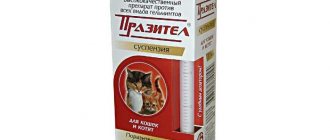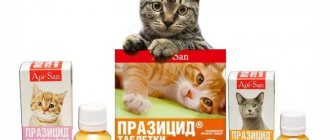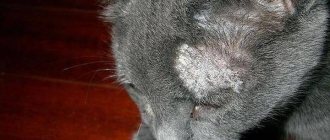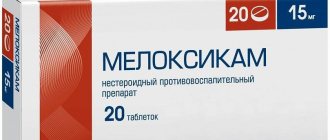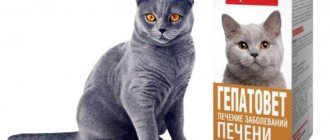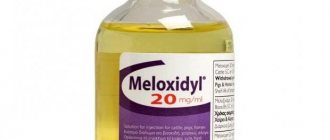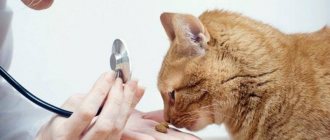Pet owners are well aware of the problem of helminth infection in cats. Often, until the first serious symptoms appear, the owners are not aware of this. To combat parasites and prevent disease, in order to prevent the development of worms, medications are used. Dirofen for cats is effective, available in tablet form, as a suspension or paste.
The drug is suitable for pets of any age. It is used to combat round and ribbon-shaped parasites. The instructions for the drug contain detailed information about the composition, indications and contraindications, dosages for animals of different ages and side effects.
Properties, principle of operation
The drug has an effect against the main types of roundworms and tapeworms that parasitize the body of cats.
Deworming tablets Dirofen
The substances included in the tablets lead to the failure of metabolic processes in the body of worms and the destruction of cells. As a result, the helminth dies in a short time.
The additional active components of the tablets paralyze the parasite, which accelerates its death and prevents the laying of eggs. The medicine is active against parasites at all stages of their development.
The drug is classified as moderately dangerous.
When given according to the instructions, it does not lead to negative consequences for the cat’s health. The composition is easily tolerated by animals, regardless of age and breed. The medication does not disrupt the pet’s intestines and does not require taking laxatives or following a diet.
Composition and description
Dirofen contains 2 active ingredients - febantel and pyrantel, excipients: calcium stearate, praziquantel, talc, lactose, aerosil, carboxylmethylcellulose. The mechanism of action of the drug is the paralysis of parasites due to neuromuscular blockade under the influence of pyrantel and the destruction of cells of the digestive system of helminths due to the action of febandel. The action of two active substances leads to the death of parasites and their removal naturally from the body.
The drug is available in the form of tablets Dirofen and Dirofen Plus. The first are intended for kittens and puppies, Dirofen Plus - tablets for adult cats and dogs. Medicines are produced in the form of tablets, 6 pieces per blister.
Indications for use
Dirofen is used to prevent helminthic infections in cats and treat them. Helminth infections pose a serious danger to the animal, causing severe infestation, which without urgent treatment can lead to death.
Indications for the use of tablets are as follows:
- lesions by roundworms;
- lesions by tapeworms;
- complex infection with flat and round worms;
- prevention of helminthiasis.
Important! Kittens should not be given medicine intended for adult cats.
Veterinarians strongly recommend using the composition regularly to prevent the appearance of worms. Parasites are dangerous not only for animals, but also for humans, as they are quickly transmitted from cats to people through constant contact with the animal.
Be sure to read:
Nonestrone for cats: instructions for use, indications, dosage and duration of use
Febantel
Stylab / Catalog / Antihelmintics / Febantel
STYLAB offers febantel standards for its analysis in food raw materials and products by chromatographic methods in accordance with GOST 32834-2014.
| Standards and standard solutions | Anthelmintic standards for analysis in accordance with GOST 32834-2014 |
Febantel is a substance related to benzimidazoles. In the body of mammals, it is metabolized to fenbendazole or oxfendazole, which have anthelmintic activity. Febantel is used to combat larval and adult stages of roundworms affecting the gastrointestinal tract or lungs, as well as against tapeworms. In addition, febantel is classified as an antiprotozoal agent and is used to treat giardiasis. In the Russian Federation, 7 drugs containing febantel are registered as veterinary drugs. They are intended for the prevention and treatment of helminthiasis and giardiasis in dogs and cats.
When administered orally, febantel is moderately well (25-30%) absorbed into the gastrointestinal tract and then metabolized in the liver. Nine febantel metabolites have been identified in rats, some of which exhibit biological activity. The highest concentrations of this substance and its metabolites are created in the liver and kidneys. Febantel is excreted from the body in feces and urine, and is also able to pass into milk.
The acute toxicity of febantel to mammals is low. Its LD50 for rats, mice and dogs when taken orally exceeds 10,000 mg/kg body weight, for rabbits it is 1250 mg/kg body weight. Upon contact with the skin and mucous membranes, this anthelmintic irritates them.
In an experiment on rats that consumed febantel daily in doses of 0, 20, 50 and 250 mg/kg for 3 months, the only sign of poisoning was fatty infiltration of the liver. In a study in dogs, groups receiving more than 5 mg/kg body weight of febantel daily for 13 weeks had decreased hematocrit, red blood cell, white blood cell, and hemoglobin levels, increased liver enzyme activity, and splenic and testicular atrophy. Food refusal, diarrhea and ataxia were observed in some animals.
A study of chronic exposure to febantel showed that this substance exhibits reproductive toxicity. In studies on rats, febantel at a dosage of 100 mg/kg body weight caused a decrease in embryo weight and an increase in the incidence of resorption. It also exhibited a teratogenic effect, manifested in disruption of the development of the eyes and skeleton of the limbs. Apparently, this effect is due to the metabolite of febantel, oxfenbendazole. In addition, febantel has hepatotoxic properties: degeneration of liver cells was observed in dogs receiving 1000 mg/kg of this substance. Febantel does not exhibit genotoxic or carcinogenic properties.
Febantel is dangerous to aquatic organisms both with single and long-term exposure. For daphnia, its EC50 is 216.5 µg/l over 48 hours. It is also toxic to fish embryos due to the conversion of febantel to fenbendazole and oxfendazole. Febantel is stable in water and can be transported over considerable distances with its current.
In the Russian Federation and the countries of the EAEU, maximum permissible levels (MAL) of febantel in food products of animal origin are not established by law. In the European Union, the MRLs for febantel are specified in regulation 2377/90. Meat, fat and kidneys of ruminant animals should not contain residues of this anthelmintic that can be oxidized to oxfendazole sulfone in a concentration of more than 50 mcg/kg, liver - more than 500 mcg/kg. In addition, the content of febantel in milk is limited to no more than 10 mcg/kg.
In the Russian Federation, GOST 32834-2014 “Food products, food raw materials. Method for determining the residual content of anthelmintics using high-performance liquid chromatography with a mass spectrometric detector.” It describes in detail the methodology for analyzing anthelmintic drugs, including febantel, in food raw materials and contains requirements for materials, including standards. STYLAB offers pure febantel substances and its mixtures with other anthelmintics. Certified Standard Manufacturers are accredited to ISO 17034:2016. Certified standards are accompanied by certificates.
Literature
- Febantel. Pubchem
- Febantel. Inchem
- COMMITTEE FOR MEDICINAL PRODUCTS FOR VETERINARY USE FEBANTEL (Extrapolation to all ruminants) SUMMARY REPORT (4). EMEA/MRL/867/03-FINAL June 2004
- Babić, S., Pavlović, D.M., Biošić, M. et al. Fate of febantel in the aquatic environment—the role of abiotic elimination processes Environ Sci Pollut Res (2018) 25: 28917.
- Carlsson G, Patring J, Kreuger J, Norrgren L, Oskarsson A. Toxicity of 15 veterinary pharmaceuticals in zebrafish (Danio rerio) embryos. Aquat Toxicol. 2013 Jan 15;126:30-41.
←Return
Directions for use, dosage for cats
The anthelmintic should be given in the morning, mixed into the food. You can use both ready-made pet food and natural food. The product into which the medicine will be mixed will not affect its effectiveness.
Typically, a single use of the product is sufficient. In case of severe damage, to obtain a guaranteed result, treatment against worms is carried out twice with a gap of 10 days.
The drug tablet is designed for an animal weighing up to 5 kg.
Dirofen for kittens
The dose is the same for cats older than one year. Kittens are given a product intended for their age, also in most cases in the amount of one tablet. In Dirofen for kittens, the amount of the active component is reduced by 4 times compared to the adult drug.
For prevention, the drug is given once a quarter. Additionally, deworming may be required before vaccinations. The procedure is carried out 10 days before the injection.
It is allowed, if necessary, to use medication for cats during pregnancy. According to veterinary indications, the composition can be given 20 days before the birth of kittens. The dose is read individually by a specialist. In case of urgent need, lactating females are given the composition only 3 weeks after birth.
Release form of Dirofen for dogs
► Dirofen anti-worm tablets for dogs are available in two sizes. Some are intended for large breed dogs, others for small breeds, as well as puppies. The tablets are white in color and are packaged in plastic packaging of six pieces. The product consists of the following components:
- fenbendazole;
- pyrantel pamoate;
- auxiliary elements.
► Dirofen paste for puppies and dogs is a thick consistency product packaged in a ten-millimeter polymer syringe. It includes:
- Praziquantel.
- Pyrantela pamoate.
- Pumpkin seed oil.
- Additional components.
► Dirofen suspension for puppies and adult dogs is placed in containers made of polymer material and having a volume of 10 milliliters. The packaging is equipped with a convenient syringe dispenser and stickers that need to be pasted into the dog’s veterinary passport. The drug looks like a yellow liquid emulsion; it contains the following components: pyrantel pamoate, praziquantel and pumpkin seed oil.
When administered orally, the active substances begin to actively affect the cell membranes, paralyzing and destroying parasites.
Compound
The mechanism of action of fenbendazole and pyrantel pamoate, included in Dirofen for dogs, is based on inhibition of fumarate reductase, persistent depolarization of helminth muscle cells, and disruptions in energy metabolism.
| Kind of animal | Pill weight, grams | Pyrantel, mg | Praziquantel, mg | Febantel, mg |
| Puppies | 0,12 | 15 | 5 | 15 |
| Small and medium breeds | 0,2 | 75 | 25 | 75 |
| Large breeds | 1 | 300 | 100 | 300 |
When taken orally, febendazole and pyrantel pamoate are absorbed by the digestive system, then exit the body mainly during bowel movements and partly during urination within 1-2 days.
Dirofen tablets, according to their effects, belong to the category of moderately hazardous substances: hazard class 3, in prescribed doses they do not have an embryotoxic, teratogenic or sensitizing effect.
Contraindications and possible side effects
There are contraindications to the use of the product. Their compliance is strictly mandatory. Violations will lead to a serious deterioration in the animal’s condition and may even cause death.
Do not use the medicine for the following conditions:
- first half of pregnancy;
- the first 3 weeks after lambing;
- infectious pathologies;
- recovery period after illness;
- less than 3 weeks old;
- exhaustion;
- weight less than 500 g;
- intolerance to the components of the tablets.
Side effects from using the drug may occur in case of overdose.
When intoxication develops in an animal, the following symptoms are noted:
- oppression;
- loss of appetite;
- vomit;
- salivation;
- digestive disorders.
In case of such phenomena, you should immediately consult a veterinarian. Self-medication poses a serious danger to your pet.
Be sure to read:
Painkillers for cats and kittens: what can be given, the best drugs and folk remedies
In cases where it is not possible to visit the clinic, the animal must be given sorbents and antiallergic drugs. The most effective administration of Suprastin is subcutaneous in an amount of 0.5 ml per adult cat.
Details
Indications for use
Dirofen is used for infection with nematodes, cestodias, and mixed helminthic infestations. As a preventative measure, Dirofen is recommended to be taken once every 3 months. All cats, not only those who walk freely on the street, but also those who live permanently in your home, need to be treated for worms, that is, dewormed.
You can become infected with worms not only from an infected animal. After all, worms can get into the house on the soles of shoes, with dirty hands. Infection is also facilitated by the consumption of raw meat by animals.
Dirofen for cats - instructions for use
Dirofen suspension or tablets are given to the pet 10 days before vaccination. For helminthization, the drug is given to the cat once in the dosage specified by the manufacturer in the instructions. If worms have severely affected the cat’s body, repetition is recommended.
The dosage is calculated depending on the form of the drug and the weight of the animal. Thus, the Dirofen tablet for cats is given according to the instructions: 120 mg of the drug is calculated for 1 kg of animal weight, 200 mg for 5 kg. Tablets with the smallest dosage of less than 120 mg are suitable for a small kitten.
Dirofen suspension for kittens is calculated based on their weight. 1 ml of Dirofen per 1 kg of animal weight. Dirofen in paste for kittens is also calculated based on its weight - 1 ml of Dirofen per 1 kg of animal. An anthelmintic is given before the cat's morning feeding.
The tablet is placed on the root of the tongue, the cat’s mouth is closed and they wait until it swallows it. If it is a liquid form, that is, a suspension or paste, then the medicine is squeezed into the cat’s mouth using a syringe.
Advice If the cat does not swallow the Dirofen tablet, stick it into a sausage or meat treat.
Contraindications and side effects
Like all medications, Dirofen has contraindications for use:
- the animal is less than 3 weeks old,
- if the animal has recently undergone illness or surgery,
— the use of Dirofen is not recommended in the presence of individual intolerance to the components,
— not recommended during pregnancy and lactation.
Side effects from taking the drug can also in rare cases occur during the first use. Among them: gastrointestinal upset, increased salivation. Don't worry, the side effects will go away on their own.
Cost and analogues of Dirofen
The medicine is inexpensive. Its cost, depending on the dosage, ranges from 100 to 150 rubles.
Dirofen is an inexpensive drug
If the use of the drug is contraindicated for some reason, then its analogues are prescribed.
The main ones are:
- Prazicide;
- Drontal;
- Pyrantel;
- Febantel;
- Praziquantel;
- Profender.
Before using the analogue, it is recommended to consult a veterinarian.
Instructions for use of the drug Dirofen for dogs
The use of Dirofen is individual for each case; it is advisable to give it to the dog during the morning meal, with food or a small amount of his favorite treat.
The dog does not require fasting, the use of laxative medications or a special diet before using the product. The recommended single dosage is shown in the table:
| To whom is it assigned? | Tablet weight in mg | Unit of dog mass per pill in kg |
| Puppies | 120 | 1 |
| Small dog breeds | 200 | 5 |
| Large breed dogs | 1000 | 20 |
Storage conditions
In the manufacturer's sealed packaging, in a dry place, protected from direct sunlight and out of reach of children and animals, separately from food and feed at a temperature of 0°C to 25°C. Shelf life in unopened packaging, subject to storage conditions, is 2 years from the date of manufacture. Half a tablet is stored for 1 month.
Do not use the drug after the expiration date.
Unused drug is disposed of in accordance with legal requirements.

